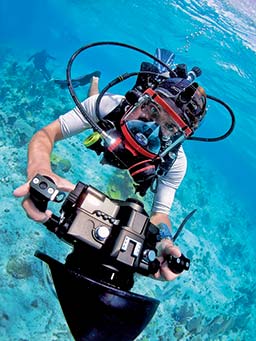Learning about oceans and learning about others. Not a bad way for students to spend their time.
Fortunately, more and more students are getting exactly that opportunity through a growing number of programs targeted toward educating children about the marine environment and its importance.
Two of these programs, the annual Youth Education Summit, sponsored by the National Association of Black Scuba Divers (NABS), and Ocean for Life, held at the University of California at Santa Barbara and the Channel Islands National Marine Sanctuary, brought together high school students from the United States and other parts of the world to learn both the importance of learning about our oceans and each other.

The Youth Education Summit is the brainchild of Kenneth Stewart, chairman of the NABS youth committee. “We believe it is important for the program to emphasize marine sciences to enhance knowledge and respect for marine life,” said Stewart. “But in a larger sense, we strive to build character.”
The summit’s concept is “to bring together youth with an interest in the marine sciences, providing them with educational experiences that enhance their knowledge of and respect for marine life, while promoting safe and skilled exploration of the seas through scuba diving.”
The participants spend the majority of their time learning and performing hands-on marine science activities. During their time together, they also perform a community service project and participate in culturally broadening experiences. A day of scuba diving or snorkeling further enhances the participants’ focus on marine sciences. Summit locations vary, though each tries to host the event in proximity to a marine sanctuary. The 2011 summit was held at Savannah State University in Georgia near the Gray’s Reef National Marine Sanctuary, and next year’s event will take place in Houston, Texas.
Ocean for Life: One World, One Ocean is a program designed to gather young people from around the world to “enhance cultural understanding through ocean science.” This year’s 12-day program brought together students from the U.S. and Middle East to learn about climate change, ocean acidification, blue whale ship strikes, global shipping, the Chumash native peoples, kelp forest ecosystems and the marine life of the Santa Barbara Channel. During it all, participants were also introduced to and gained an appreciation for the diverse cultures represented in the program.

They learned to document it as well. Throughout the Ocean for Life experience, National Geographic photographers taught participants how to use photography, video and narratives to share what they learned and promote ocean conservation and cultural understanding among their classmates, friends, families and communities.
Both the NABS Youth Education Summit and Ocean for Life programs offer either full tuition or partial scholarships to aid qualified participants in need of financial support.
Both programs also enjoy key partnerships with organizations such as the National Oceanic and Atmospheric Administration (NOAA) Office of National Marine Sanctuaries. By supplying experienced, knowledgeable staff and facilities within or adjacent to national marine sanctuaries, NOAA strives to advance their mission and to support the future of oceans and those who will study them.
“Whether they live in America’s central cities and suburbs or countries in the Middle East, the next generation of leaders will determine how we solve the threats facing the ocean,” said Daniel J. Basta, director of NOAA’s Office of National Marine Sanctuaries. “The NABS Youth Education Summit and Ocean for Life initiatives represent our commitment to help today’s young people be more informed about ocean and environmental issues, and show them how they can work together to jointly navigate a changing world.”
© Alert Diver — Q4 Fall 2011